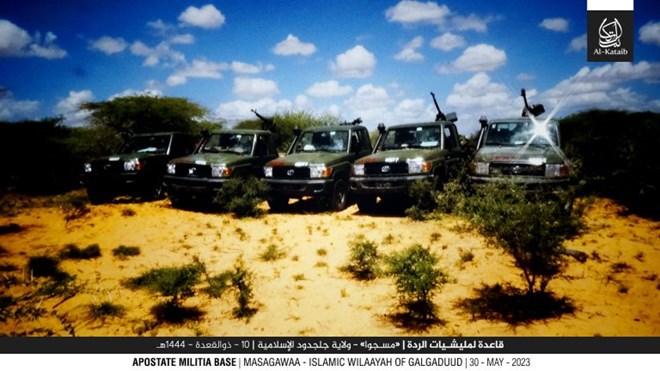
Friday June 2, 2023
BY BILL ROGGIO AND CALEB WEISS
 Captured Somali military vehicles from Masagaway, as seen from Shabaab’s propaganda
Captured Somali military vehicles from Masagaway, as seen from Shabaab’s propagandaJust days after Shabaab, al Qaeda’s branch in East Africa, overran a Ugandan military base in southern Somalia, its men again raided another major outpost in central Somalia. Targeting a Somali special forces base in the central Galguduud Region, the assault targeted newly deployed troops freshly trained in Eritrea.
On Tuesday, Shabaab launched a major suicide assault on the Somali military base in the town of Masagaway in Galguduud. The jihadists began the raid with at least one suicide car bomb before the much larger assault team stormed the base. However, exact details then vary on what exactly occurred next. According to the Somali government, the soldiers fought back, killing at least 30 Shabaab fighters before forcing the jihadis to withdraw.
Unsurprisingly, Shabaab has painted an entirely different picture. According to its media, it initially claimed to have killed at least 73 Somali soldiers while also capturing copious amounts of weapons, equipment, and vehicles. It has since raised its tally to more than 149 troops killed. Undercutting the Somali government’s claims, it also released photos that appear to confirm many elements of its story including that the attack was not easily repulsed.
And though the al Qaeda branch does show many killed Somali troops in its propaganda, it does still inflate the total number of those killed. In return, Somali state media has released its own counter-propaganda, with video of reinforcements showing up from nearby Ceeldheer to help secure the Masagaway base during the fighting.
Masagaway was recently re-captured from Shabaab control just earlier this year. Shabaab previously attacked a Macaawisley base (clan-based militia fighting on the side of the Somali government against Shabaab) in the town in April. Though the town is nominally in government hands, the attacks demonstrate Shabaab’s continued freedom of movement in the area.
The Somali government has slowed down offensive operations against Shabaab in the country’s center, where it previously sustained major pressure against the jihadi group since last summer. Additionally, the Somali government continues to delay the beginning of the so-called “Phase Two” of the counter-Shabaab offensives, which are supposed to take place in Somalia’s southern states of Jubaland and South-West State.
However, the pause in any major offensives has allowed Shabaab to regain momentum and launch these recent successive attacks against major military bases in two different parts of the country. The raids are likely to continue as Shabaab is given more breathing room to consolidate, regroup, and refocus its forces.
At the same time, the United States has attempted to offset some of the slowed Somali campaign against the jihadi group. For instance, on May 20 U.S. Africa Command targeted Maalim Osman, the emir of Shabaab’s external operations wing, in a drone strike near Shabaab’s southern stronghold of Jilib (though it is believed the terrorist leader survived). AFRICOM reported that an unnamed Shabaab operative was assessed to have been wounded in the strike.
And during Shabaab’s May 26 raid on the Ugandan military base in Buulo Mareer, in which scores of Ugandan troops are thought to have been killed and wounded and military hardware was seized, AFRICOM launched another strike against Shabaab. AFRICOM reported that the strike “destroyed weapons and equipment unlawfully taken by al Shabaab fighters.” AFRICOM did not report any Shabaab fighters killed or wounded during the strike.
AFRICOM has launched nine strikes against Shabaab in Somalia since the beginning of 2023, according to data compiled by FDD’s Long War Journal. Last year, the U.S. military command launched 15 strikes against Shabaab. In one of those operations, the U.S. killed Abdullahi Yare, a Shabaab commander and co-founder of the terror group who had a $3 million reward out for his capture. The U.S. has launched at least 251 strikes inside Somalia since 2007, based on FDD’s Long War Journal data.
The U.S. military has been attacking Shabaab using air power as the Somali government has been attempting to wrest control of Shabaab-held territory in central and southern Somalia. A majority of the strikes are what AFRICOM describes as “defensive,” meaning they were launched to support Somali forces as they were being attacked by Shabaab. However, in some cases, such as the strike against Maalim Osman, the strikes are described as counter-terror operations.
AFRICOM continues to describe Shabaab as “the largest and most deadly al Qaeda network in the world.” And though its fortunes have ebbed and flowed over the past decade, it has also weathered numerous offensives from an array of local, regional, and international actors, including the United States.
The two successive base attacks in less than a week across two distinct areas of Somalia provide a stark warning for how the fight against the al Qaeda branch is far from over.
Bill Roggio is a Senior Fellow at the Foundation for Defense of Democracies and the Editor of The Long War Journal. Caleb Weiss is a research analyst at FDD's Long War Journal and a senior analyst at the Bridgeway Foundation, where he focuses on the spread of the Islamic State in Central Africa.